RMIT University MKTG11014 Marketing Research Exam S1 2018 Solution
VerifiedAdded on 2023/06/11
|12
|3530
|495
Quiz and Exam
AI Summary
This document presents a comprehensive solution to the RMIT University MKTG11014 Marketing Research final exam from Semester 1 2018. The solution addresses three key questions: customer experience, research plan, and brand positioning. The customer experience section critically evaluates a draft questionnaire, designs an improved data collection instrument, recommends data collection and sampling methods, and suggests appropriate data analysis techniques. The research plan section recommends research designs and data collection methods, describes implementation strategies, and suggests data analysis techniques, including descriptive statistics and hypothesis testing. The brand positioning section explains how a company like Label can monitor its brand positioning continuously, recommending strategies such as understanding customer decision-making processes and developing sustainable brands to combat increasing competition from international retailers. Desklib offers a wide array of solved assignments and study resources for students.
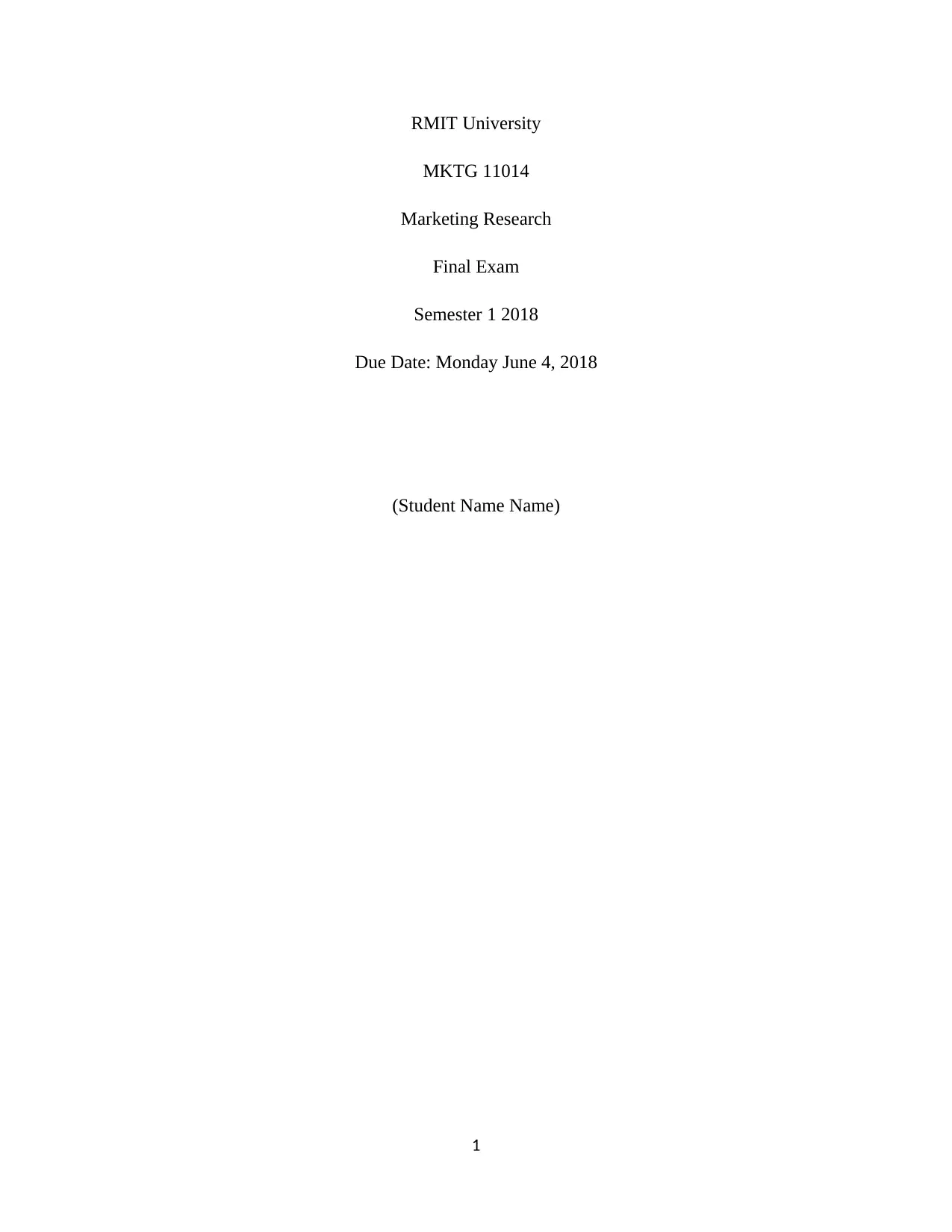
RMIT University
MKTG 11014
Marketing Research
Final Exam
Semester 1 2018
Due Date: Monday June 4, 2018
(Student Name Name)
1
MKTG 11014
Marketing Research
Final Exam
Semester 1 2018
Due Date: Monday June 4, 2018
(Student Name Name)
1
Paraphrase This Document
Need a fresh take? Get an instant paraphrase of this document with our AI Paraphraser
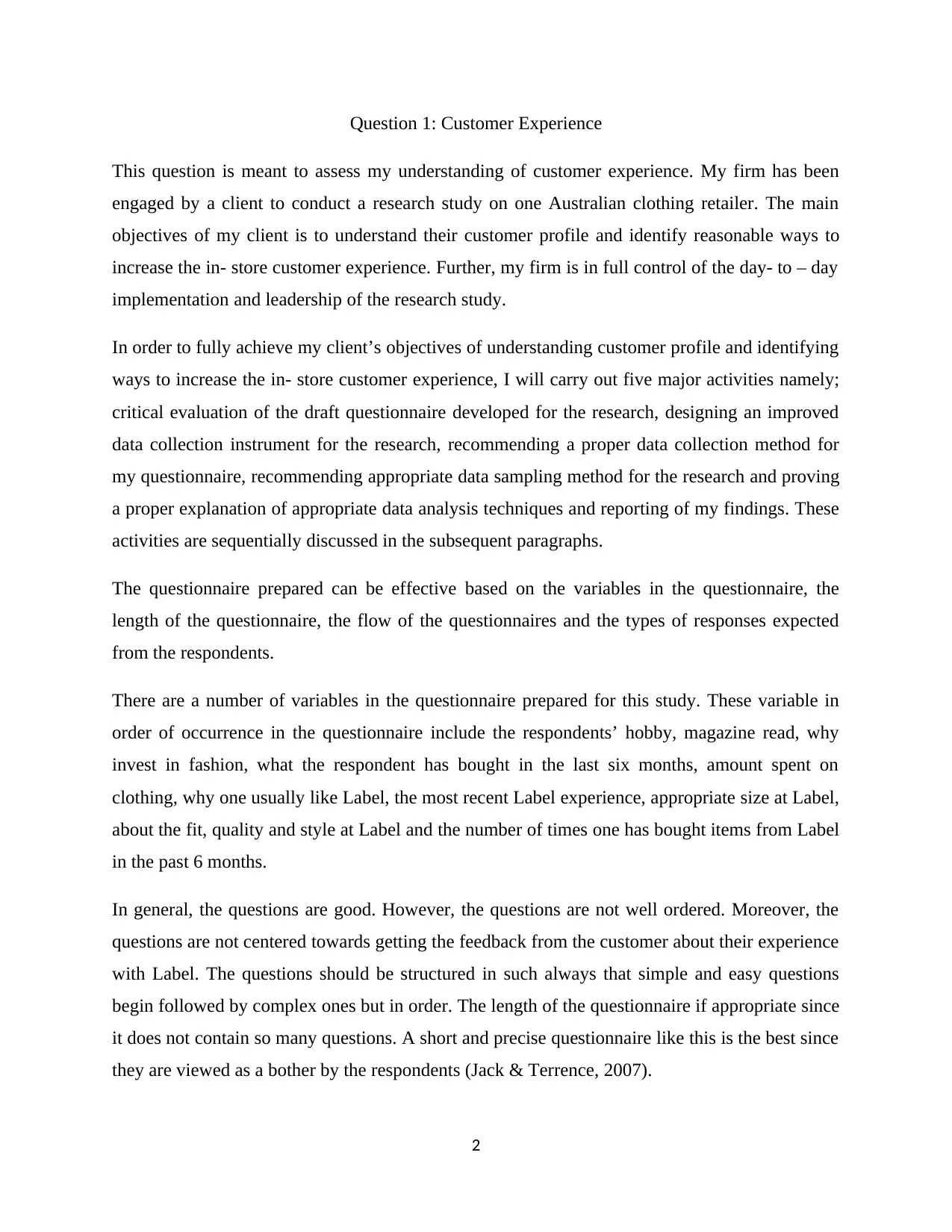
Question 1: Customer Experience
This question is meant to assess my understanding of customer experience. My firm has been
engaged by a client to conduct a research study on one Australian clothing retailer. The main
objectives of my client is to understand their customer profile and identify reasonable ways to
increase the in- store customer experience. Further, my firm is in full control of the day- to – day
implementation and leadership of the research study.
In order to fully achieve my client’s objectives of understanding customer profile and identifying
ways to increase the in- store customer experience, I will carry out five major activities namely;
critical evaluation of the draft questionnaire developed for the research, designing an improved
data collection instrument for the research, recommending a proper data collection method for
my questionnaire, recommending appropriate data sampling method for the research and proving
a proper explanation of appropriate data analysis techniques and reporting of my findings. These
activities are sequentially discussed in the subsequent paragraphs.
The questionnaire prepared can be effective based on the variables in the questionnaire, the
length of the questionnaire, the flow of the questionnaires and the types of responses expected
from the respondents.
There are a number of variables in the questionnaire prepared for this study. These variable in
order of occurrence in the questionnaire include the respondents’ hobby, magazine read, why
invest in fashion, what the respondent has bought in the last six months, amount spent on
clothing, why one usually like Label, the most recent Label experience, appropriate size at Label,
about the fit, quality and style at Label and the number of times one has bought items from Label
in the past 6 months.
In general, the questions are good. However, the questions are not well ordered. Moreover, the
questions are not centered towards getting the feedback from the customer about their experience
with Label. The questions should be structured in such always that simple and easy questions
begin followed by complex ones but in order. The length of the questionnaire if appropriate since
it does not contain so many questions. A short and precise questionnaire like this is the best since
they are viewed as a bother by the respondents (Jack & Terrence, 2007).
2
This question is meant to assess my understanding of customer experience. My firm has been
engaged by a client to conduct a research study on one Australian clothing retailer. The main
objectives of my client is to understand their customer profile and identify reasonable ways to
increase the in- store customer experience. Further, my firm is in full control of the day- to – day
implementation and leadership of the research study.
In order to fully achieve my client’s objectives of understanding customer profile and identifying
ways to increase the in- store customer experience, I will carry out five major activities namely;
critical evaluation of the draft questionnaire developed for the research, designing an improved
data collection instrument for the research, recommending a proper data collection method for
my questionnaire, recommending appropriate data sampling method for the research and proving
a proper explanation of appropriate data analysis techniques and reporting of my findings. These
activities are sequentially discussed in the subsequent paragraphs.
The questionnaire prepared can be effective based on the variables in the questionnaire, the
length of the questionnaire, the flow of the questionnaires and the types of responses expected
from the respondents.
There are a number of variables in the questionnaire prepared for this study. These variable in
order of occurrence in the questionnaire include the respondents’ hobby, magazine read, why
invest in fashion, what the respondent has bought in the last six months, amount spent on
clothing, why one usually like Label, the most recent Label experience, appropriate size at Label,
about the fit, quality and style at Label and the number of times one has bought items from Label
in the past 6 months.
In general, the questions are good. However, the questions are not well ordered. Moreover, the
questions are not centered towards getting the feedback from the customer about their experience
with Label. The questions should be structured in such always that simple and easy questions
begin followed by complex ones but in order. The length of the questionnaire if appropriate since
it does not contain so many questions. A short and precise questionnaire like this is the best since
they are viewed as a bother by the respondents (Jack & Terrence, 2007).
2
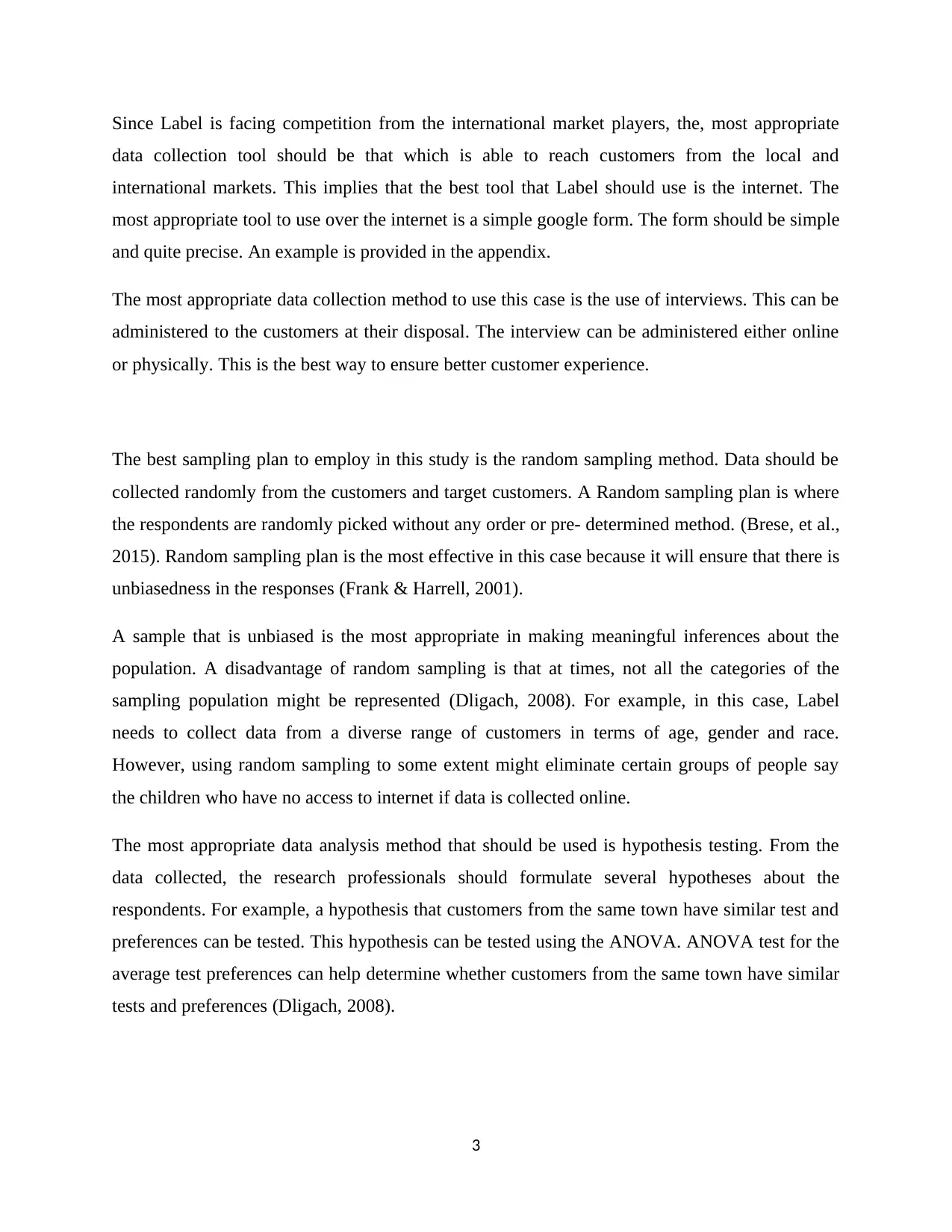
Since Label is facing competition from the international market players, the, most appropriate
data collection tool should be that which is able to reach customers from the local and
international markets. This implies that the best tool that Label should use is the internet. The
most appropriate tool to use over the internet is a simple google form. The form should be simple
and quite precise. An example is provided in the appendix.
The most appropriate data collection method to use this case is the use of interviews. This can be
administered to the customers at their disposal. The interview can be administered either online
or physically. This is the best way to ensure better customer experience.
The best sampling plan to employ in this study is the random sampling method. Data should be
collected randomly from the customers and target customers. A Random sampling plan is where
the respondents are randomly picked without any order or pre- determined method. (Brese, et al.,
2015). Random sampling plan is the most effective in this case because it will ensure that there is
unbiasedness in the responses (Frank & Harrell, 2001).
A sample that is unbiased is the most appropriate in making meaningful inferences about the
population. A disadvantage of random sampling is that at times, not all the categories of the
sampling population might be represented (Dligach, 2008). For example, in this case, Label
needs to collect data from a diverse range of customers in terms of age, gender and race.
However, using random sampling to some extent might eliminate certain groups of people say
the children who have no access to internet if data is collected online.
The most appropriate data analysis method that should be used is hypothesis testing. From the
data collected, the research professionals should formulate several hypotheses about the
respondents. For example, a hypothesis that customers from the same town have similar test and
preferences can be tested. This hypothesis can be tested using the ANOVA. ANOVA test for the
average test preferences can help determine whether customers from the same town have similar
tests and preferences (Dligach, 2008).
3
data collection tool should be that which is able to reach customers from the local and
international markets. This implies that the best tool that Label should use is the internet. The
most appropriate tool to use over the internet is a simple google form. The form should be simple
and quite precise. An example is provided in the appendix.
The most appropriate data collection method to use this case is the use of interviews. This can be
administered to the customers at their disposal. The interview can be administered either online
or physically. This is the best way to ensure better customer experience.
The best sampling plan to employ in this study is the random sampling method. Data should be
collected randomly from the customers and target customers. A Random sampling plan is where
the respondents are randomly picked without any order or pre- determined method. (Brese, et al.,
2015). Random sampling plan is the most effective in this case because it will ensure that there is
unbiasedness in the responses (Frank & Harrell, 2001).
A sample that is unbiased is the most appropriate in making meaningful inferences about the
population. A disadvantage of random sampling is that at times, not all the categories of the
sampling population might be represented (Dligach, 2008). For example, in this case, Label
needs to collect data from a diverse range of customers in terms of age, gender and race.
However, using random sampling to some extent might eliminate certain groups of people say
the children who have no access to internet if data is collected online.
The most appropriate data analysis method that should be used is hypothesis testing. From the
data collected, the research professionals should formulate several hypotheses about the
respondents. For example, a hypothesis that customers from the same town have similar test and
preferences can be tested. This hypothesis can be tested using the ANOVA. ANOVA test for the
average test preferences can help determine whether customers from the same town have similar
tests and preferences (Dligach, 2008).
3
⊘ This is a preview!⊘
Do you want full access?
Subscribe today to unlock all pages.

Trusted by 1+ million students worldwide
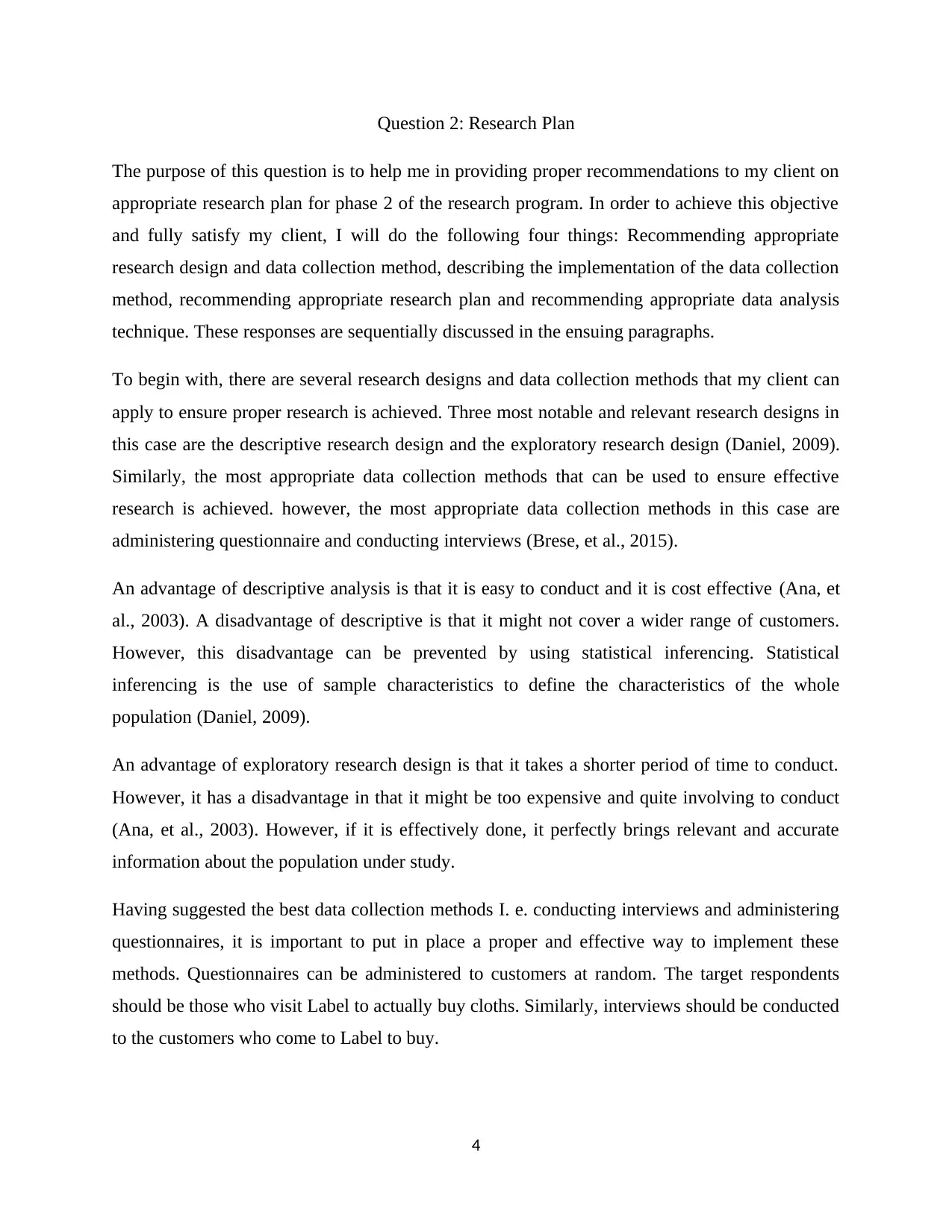
Question 2: Research Plan
The purpose of this question is to help me in providing proper recommendations to my client on
appropriate research plan for phase 2 of the research program. In order to achieve this objective
and fully satisfy my client, I will do the following four things: Recommending appropriate
research design and data collection method, describing the implementation of the data collection
method, recommending appropriate research plan and recommending appropriate data analysis
technique. These responses are sequentially discussed in the ensuing paragraphs.
To begin with, there are several research designs and data collection methods that my client can
apply to ensure proper research is achieved. Three most notable and relevant research designs in
this case are the descriptive research design and the exploratory research design (Daniel, 2009).
Similarly, the most appropriate data collection methods that can be used to ensure effective
research is achieved. however, the most appropriate data collection methods in this case are
administering questionnaire and conducting interviews (Brese, et al., 2015).
An advantage of descriptive analysis is that it is easy to conduct and it is cost effective (Ana, et
al., 2003). A disadvantage of descriptive is that it might not cover a wider range of customers.
However, this disadvantage can be prevented by using statistical inferencing. Statistical
inferencing is the use of sample characteristics to define the characteristics of the whole
population (Daniel, 2009).
An advantage of exploratory research design is that it takes a shorter period of time to conduct.
However, it has a disadvantage in that it might be too expensive and quite involving to conduct
(Ana, et al., 2003). However, if it is effectively done, it perfectly brings relevant and accurate
information about the population under study.
Having suggested the best data collection methods I. e. conducting interviews and administering
questionnaires, it is important to put in place a proper and effective way to implement these
methods. Questionnaires can be administered to customers at random. The target respondents
should be those who visit Label to actually buy cloths. Similarly, interviews should be conducted
to the customers who come to Label to buy.
4
The purpose of this question is to help me in providing proper recommendations to my client on
appropriate research plan for phase 2 of the research program. In order to achieve this objective
and fully satisfy my client, I will do the following four things: Recommending appropriate
research design and data collection method, describing the implementation of the data collection
method, recommending appropriate research plan and recommending appropriate data analysis
technique. These responses are sequentially discussed in the ensuing paragraphs.
To begin with, there are several research designs and data collection methods that my client can
apply to ensure proper research is achieved. Three most notable and relevant research designs in
this case are the descriptive research design and the exploratory research design (Daniel, 2009).
Similarly, the most appropriate data collection methods that can be used to ensure effective
research is achieved. however, the most appropriate data collection methods in this case are
administering questionnaire and conducting interviews (Brese, et al., 2015).
An advantage of descriptive analysis is that it is easy to conduct and it is cost effective (Ana, et
al., 2003). A disadvantage of descriptive is that it might not cover a wider range of customers.
However, this disadvantage can be prevented by using statistical inferencing. Statistical
inferencing is the use of sample characteristics to define the characteristics of the whole
population (Daniel, 2009).
An advantage of exploratory research design is that it takes a shorter period of time to conduct.
However, it has a disadvantage in that it might be too expensive and quite involving to conduct
(Ana, et al., 2003). However, if it is effectively done, it perfectly brings relevant and accurate
information about the population under study.
Having suggested the best data collection methods I. e. conducting interviews and administering
questionnaires, it is important to put in place a proper and effective way to implement these
methods. Questionnaires can be administered to customers at random. The target respondents
should be those who visit Label to actually buy cloths. Similarly, interviews should be conducted
to the customers who come to Label to buy.
4
Paraphrase This Document
Need a fresh take? Get an instant paraphrase of this document with our AI Paraphraser

A part from targeting those customers who have actually come to purchase some cloths, the
management should also hire research assistants to help in collecting data from different parts
with customers and target customers. Another effective way of implementing an effective data
collection is through the use of online platforms such as company website and social sites with
customer reach. Online platforms will ensure that a wider customer range is reached and a
relatively diverse customers respond to the questionnaires (Dligach, 2008).
The best sampling plan to employ in this study is the random sampling plan. Random sampling
plan is where the respondents are randomly picked without any order or pre- determined method.
(Brese, et al., 2015). Random sampling plan is the most effective in this case because it will
ensure that there is unbiasedness in the responses (Frank & Harrell, 2001).
A sample that is unbiased is the most appropriate in making meaningful inferences about the
population. A disadvantage of random sampling is that at times, not all the categories of the
sampling population might be represented (Dligach, 2008). For example, in this case, Label
needs to collect data from a diverse range of customers in terms of age, gender and race.
However, using random sampling to some extent might eliminate certain groups of people say
the children who have no access to internet if data is collected online.
There are numerous data analysis methods. However, the most appropriate data analysis method
in this case is the use of descriptive statistics analysis and hypothesis testing. Descriptive
statistical analysis will provide vital characteristics about the data such as the mean age of the
respondents, the average test preferences and many other details. Descriptive statistics will also
provide various graphical displays of the dataset such the histograms.
Similarly, hypothesis testing can be conducted to establish whether there are relationships
between several variable say age and taste presence. Hypothesis testing can also help in
establishing whether there is significant difference in the customer preferences across the
different age brackets and even gender (Dligach, 2008). Therefore, I propose that hypothesis
testing of mean difference I. e the ANOVA test using a suitable software such as Statistical
Packages for Social Sciences (SPSS) and excel should be conducted appropriately.
Question 3: Brand Positioning
5
management should also hire research assistants to help in collecting data from different parts
with customers and target customers. Another effective way of implementing an effective data
collection is through the use of online platforms such as company website and social sites with
customer reach. Online platforms will ensure that a wider customer range is reached and a
relatively diverse customers respond to the questionnaires (Dligach, 2008).
The best sampling plan to employ in this study is the random sampling plan. Random sampling
plan is where the respondents are randomly picked without any order or pre- determined method.
(Brese, et al., 2015). Random sampling plan is the most effective in this case because it will
ensure that there is unbiasedness in the responses (Frank & Harrell, 2001).
A sample that is unbiased is the most appropriate in making meaningful inferences about the
population. A disadvantage of random sampling is that at times, not all the categories of the
sampling population might be represented (Dligach, 2008). For example, in this case, Label
needs to collect data from a diverse range of customers in terms of age, gender and race.
However, using random sampling to some extent might eliminate certain groups of people say
the children who have no access to internet if data is collected online.
There are numerous data analysis methods. However, the most appropriate data analysis method
in this case is the use of descriptive statistics analysis and hypothesis testing. Descriptive
statistical analysis will provide vital characteristics about the data such as the mean age of the
respondents, the average test preferences and many other details. Descriptive statistics will also
provide various graphical displays of the dataset such the histograms.
Similarly, hypothesis testing can be conducted to establish whether there are relationships
between several variable say age and taste presence. Hypothesis testing can also help in
establishing whether there is significant difference in the customer preferences across the
different age brackets and even gender (Dligach, 2008). Therefore, I propose that hypothesis
testing of mean difference I. e the ANOVA test using a suitable software such as Statistical
Packages for Social Sciences (SPSS) and excel should be conducted appropriately.
Question 3: Brand Positioning
5

My client Label is a proudly Australian brand offering men’s and womenswear in a range of
investment pieces and wardrobe essentials. Label has undergone significant growth in the past
six years. However, Label is facing an increasing competition in the market from international
retailers. As a marketing research expert, I will use appropriate theory and framework to explain
how a company like Label can monitor their brand positioning on a continuous basis. Further, I
will recommend appropriate research design that would be suitable for the continued evaluation
of their brand performance.
To begin with, a brand is one of the marketing practice of creating an identity, symbol or even a
name that is able to uniquely differentiate a product from the rest of the products in the market
(Brese, et al., 2015). Creating a proper brand is a key success in ensuring a company’s
sustainable growth and development (Clive, 2007). Therefore, proper branding is one of the key
responsibilities of a company’s marketing team.
Brand positioning is how effective a company develops its brand in the market among other
competing brands with perhaps the same service or commodity with the same purpose (Daniel,
2009). Brand positioning will determine how a company interacts with the competitors and the
customers’ view of the brand (Jeremy, 1998). Brand positioning will also determine the level of
competition that the company faces both internally and internationally (Clive, 2007). Therefore,
a company should appropriately position its brand in such a way that it is not heavily affected by
competition.
An increasing competition causes a lot of noise in the market. This noise may lead to customer
distractions and hence customer may have relatively difficult times in establishing a proper and
appropriate brand. Hence, it is important that a company employs appropriate brand positioning
in order to gain more customers and retain the existing customers (Robert & Reto, 2004). Proper
brand positioning will also ensure that the brand remains in the consumers’ consideration list.
My client Label faces an increasing competition from international retailers. There are a number
of recommended things that Label can do in order to ensure proper brand positioning, avoid
distractions caused to its customers and ensure that its products remain in its customers’
consideration list. One of the most important things that Label can do include developing a
6
investment pieces and wardrobe essentials. Label has undergone significant growth in the past
six years. However, Label is facing an increasing competition in the market from international
retailers. As a marketing research expert, I will use appropriate theory and framework to explain
how a company like Label can monitor their brand positioning on a continuous basis. Further, I
will recommend appropriate research design that would be suitable for the continued evaluation
of their brand performance.
To begin with, a brand is one of the marketing practice of creating an identity, symbol or even a
name that is able to uniquely differentiate a product from the rest of the products in the market
(Brese, et al., 2015). Creating a proper brand is a key success in ensuring a company’s
sustainable growth and development (Clive, 2007). Therefore, proper branding is one of the key
responsibilities of a company’s marketing team.
Brand positioning is how effective a company develops its brand in the market among other
competing brands with perhaps the same service or commodity with the same purpose (Daniel,
2009). Brand positioning will determine how a company interacts with the competitors and the
customers’ view of the brand (Jeremy, 1998). Brand positioning will also determine the level of
competition that the company faces both internally and internationally (Clive, 2007). Therefore,
a company should appropriately position its brand in such a way that it is not heavily affected by
competition.
An increasing competition causes a lot of noise in the market. This noise may lead to customer
distractions and hence customer may have relatively difficult times in establishing a proper and
appropriate brand. Hence, it is important that a company employs appropriate brand positioning
in order to gain more customers and retain the existing customers (Robert & Reto, 2004). Proper
brand positioning will also ensure that the brand remains in the consumers’ consideration list.
My client Label faces an increasing competition from international retailers. There are a number
of recommended things that Label can do in order to ensure proper brand positioning, avoid
distractions caused to its customers and ensure that its products remain in its customers’
consideration list. One of the most important things that Label can do include developing a
6
⊘ This is a preview!⊘
Do you want full access?
Subscribe today to unlock all pages.

Trusted by 1+ million students worldwide
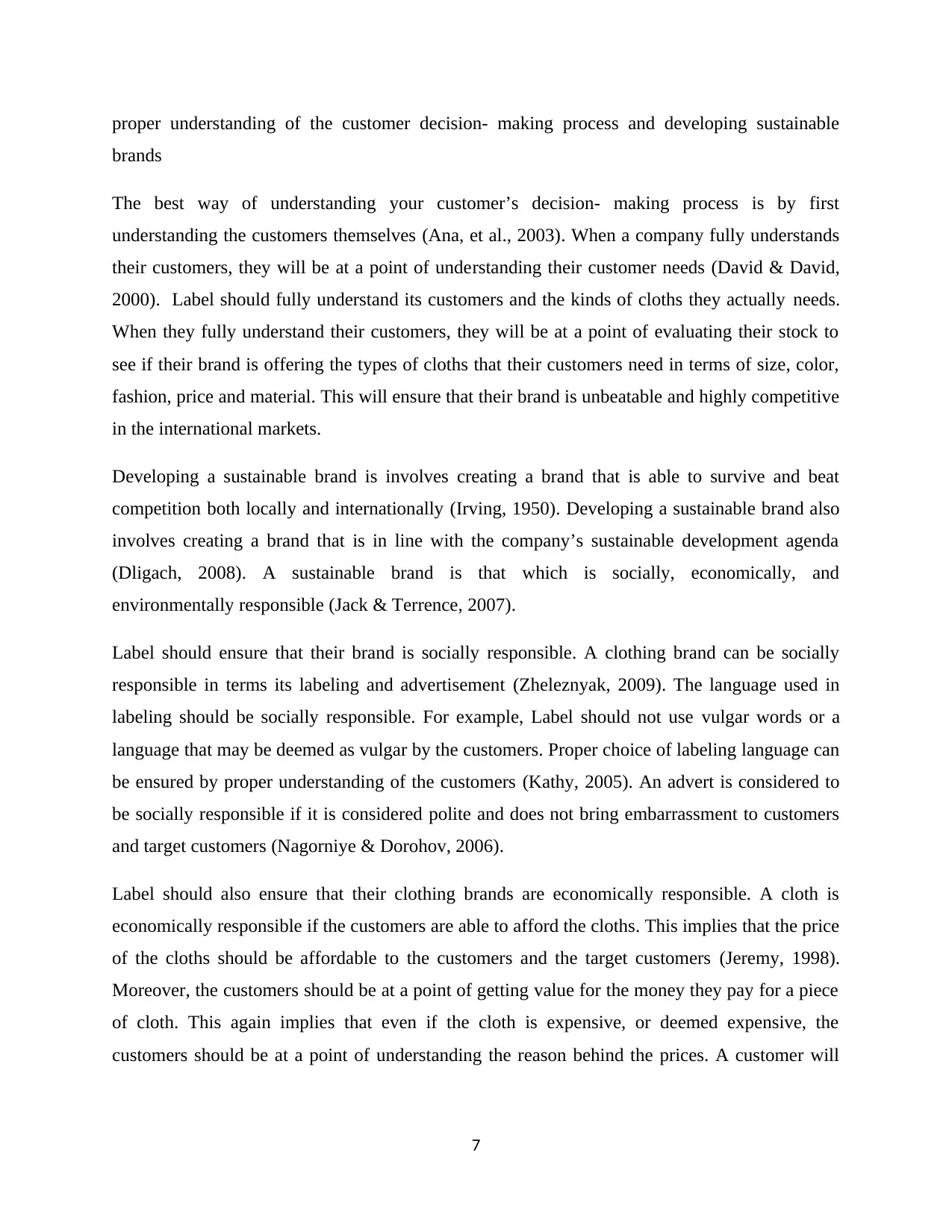
proper understanding of the customer decision- making process and developing sustainable
brands
The best way of understanding your customer’s decision- making process is by first
understanding the customers themselves (Ana, et al., 2003). When a company fully understands
their customers, they will be at a point of understanding their customer needs (David & David,
2000). Label should fully understand its customers and the kinds of cloths they actually needs.
When they fully understand their customers, they will be at a point of evaluating their stock to
see if their brand is offering the types of cloths that their customers need in terms of size, color,
fashion, price and material. This will ensure that their brand is unbeatable and highly competitive
in the international markets.
Developing a sustainable brand is involves creating a brand that is able to survive and beat
competition both locally and internationally (Irving, 1950). Developing a sustainable brand also
involves creating a brand that is in line with the company’s sustainable development agenda
(Dligach, 2008). A sustainable brand is that which is socially, economically, and
environmentally responsible (Jack & Terrence, 2007).
Label should ensure that their brand is socially responsible. A clothing brand can be socially
responsible in terms its labeling and advertisement (Zheleznyak, 2009). The language used in
labeling should be socially responsible. For example, Label should not use vulgar words or a
language that may be deemed as vulgar by the customers. Proper choice of labeling language can
be ensured by proper understanding of the customers (Kathy, 2005). An advert is considered to
be socially responsible if it is considered polite and does not bring embarrassment to customers
and target customers (Nagorniye & Dorohov, 2006).
Label should also ensure that their clothing brands are economically responsible. A cloth is
economically responsible if the customers are able to afford the cloths. This implies that the price
of the cloths should be affordable to the customers and the target customers (Jeremy, 1998).
Moreover, the customers should be at a point of getting value for the money they pay for a piece
of cloth. This again implies that even if the cloth is expensive, or deemed expensive, the
customers should be at a point of understanding the reason behind the prices. A customer will
7
brands
The best way of understanding your customer’s decision- making process is by first
understanding the customers themselves (Ana, et al., 2003). When a company fully understands
their customers, they will be at a point of understanding their customer needs (David & David,
2000). Label should fully understand its customers and the kinds of cloths they actually needs.
When they fully understand their customers, they will be at a point of evaluating their stock to
see if their brand is offering the types of cloths that their customers need in terms of size, color,
fashion, price and material. This will ensure that their brand is unbeatable and highly competitive
in the international markets.
Developing a sustainable brand is involves creating a brand that is able to survive and beat
competition both locally and internationally (Irving, 1950). Developing a sustainable brand also
involves creating a brand that is in line with the company’s sustainable development agenda
(Dligach, 2008). A sustainable brand is that which is socially, economically, and
environmentally responsible (Jack & Terrence, 2007).
Label should ensure that their brand is socially responsible. A clothing brand can be socially
responsible in terms its labeling and advertisement (Zheleznyak, 2009). The language used in
labeling should be socially responsible. For example, Label should not use vulgar words or a
language that may be deemed as vulgar by the customers. Proper choice of labeling language can
be ensured by proper understanding of the customers (Kathy, 2005). An advert is considered to
be socially responsible if it is considered polite and does not bring embarrassment to customers
and target customers (Nagorniye & Dorohov, 2006).
Label should also ensure that their clothing brands are economically responsible. A cloth is
economically responsible if the customers are able to afford the cloths. This implies that the price
of the cloths should be affordable to the customers and the target customers (Jeremy, 1998).
Moreover, the customers should be at a point of getting value for the money they pay for a piece
of cloth. This again implies that even if the cloth is expensive, or deemed expensive, the
customers should be at a point of understanding the reason behind the prices. A customer will
7
Paraphrase This Document
Need a fresh take? Get an instant paraphrase of this document with our AI Paraphraser
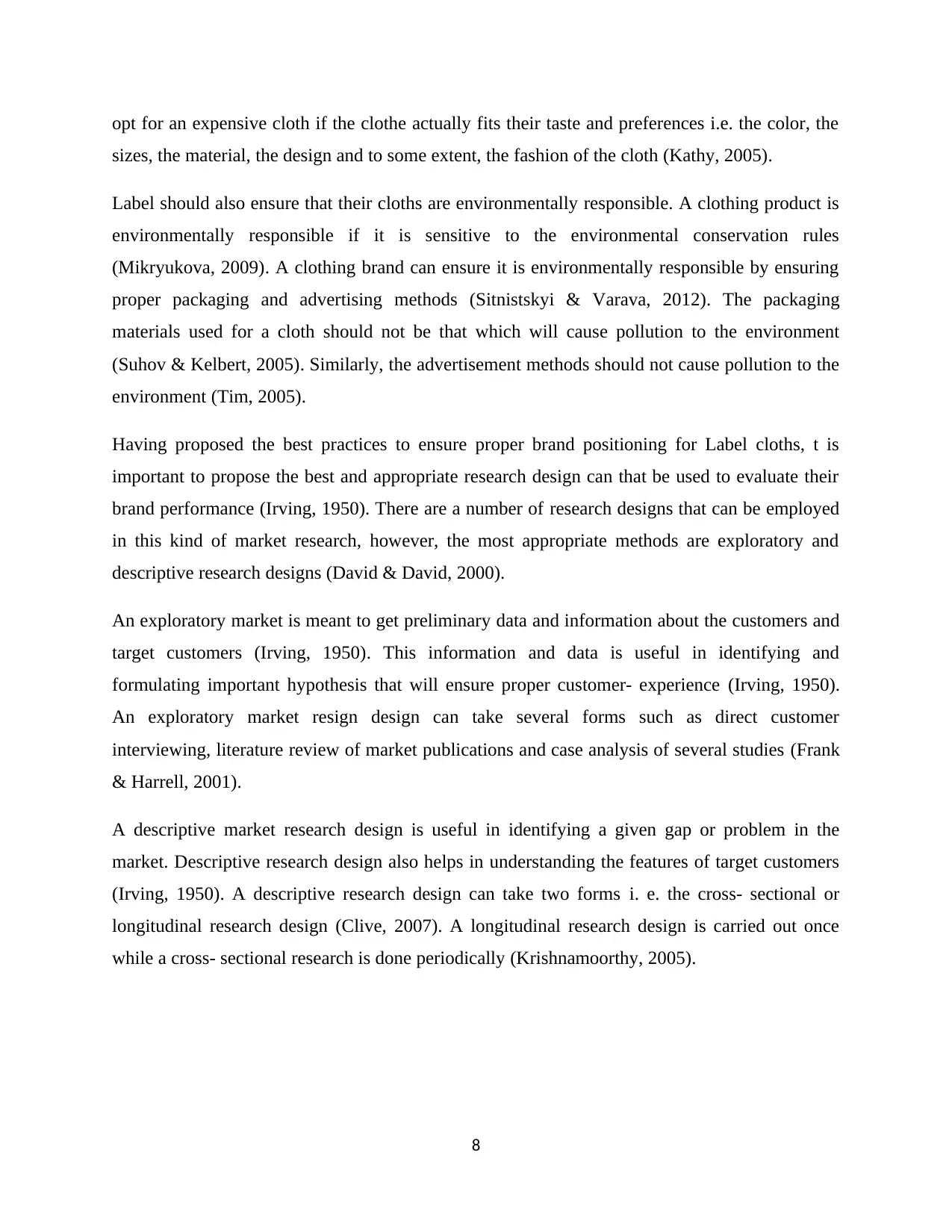
opt for an expensive cloth if the clothe actually fits their taste and preferences i.e. the color, the
sizes, the material, the design and to some extent, the fashion of the cloth (Kathy, 2005).
Label should also ensure that their cloths are environmentally responsible. A clothing product is
environmentally responsible if it is sensitive to the environmental conservation rules
(Mikryukova, 2009). A clothing brand can ensure it is environmentally responsible by ensuring
proper packaging and advertising methods (Sitnistskyi & Varava, 2012). The packaging
materials used for a cloth should not be that which will cause pollution to the environment
(Suhov & Kelbert, 2005). Similarly, the advertisement methods should not cause pollution to the
environment (Tim, 2005).
Having proposed the best practices to ensure proper brand positioning for Label cloths, t is
important to propose the best and appropriate research design can that be used to evaluate their
brand performance (Irving, 1950). There are a number of research designs that can be employed
in this kind of market research, however, the most appropriate methods are exploratory and
descriptive research designs (David & David, 2000).
An exploratory market is meant to get preliminary data and information about the customers and
target customers (Irving, 1950). This information and data is useful in identifying and
formulating important hypothesis that will ensure proper customer- experience (Irving, 1950).
An exploratory market resign design can take several forms such as direct customer
interviewing, literature review of market publications and case analysis of several studies (Frank
& Harrell, 2001).
A descriptive market research design is useful in identifying a given gap or problem in the
market. Descriptive research design also helps in understanding the features of target customers
(Irving, 1950). A descriptive research design can take two forms i. e. the cross- sectional or
longitudinal research design (Clive, 2007). A longitudinal research design is carried out once
while a cross- sectional research is done periodically (Krishnamoorthy, 2005).
8
sizes, the material, the design and to some extent, the fashion of the cloth (Kathy, 2005).
Label should also ensure that their cloths are environmentally responsible. A clothing product is
environmentally responsible if it is sensitive to the environmental conservation rules
(Mikryukova, 2009). A clothing brand can ensure it is environmentally responsible by ensuring
proper packaging and advertising methods (Sitnistskyi & Varava, 2012). The packaging
materials used for a cloth should not be that which will cause pollution to the environment
(Suhov & Kelbert, 2005). Similarly, the advertisement methods should not cause pollution to the
environment (Tim, 2005).
Having proposed the best practices to ensure proper brand positioning for Label cloths, t is
important to propose the best and appropriate research design can that be used to evaluate their
brand performance (Irving, 1950). There are a number of research designs that can be employed
in this kind of market research, however, the most appropriate methods are exploratory and
descriptive research designs (David & David, 2000).
An exploratory market is meant to get preliminary data and information about the customers and
target customers (Irving, 1950). This information and data is useful in identifying and
formulating important hypothesis that will ensure proper customer- experience (Irving, 1950).
An exploratory market resign design can take several forms such as direct customer
interviewing, literature review of market publications and case analysis of several studies (Frank
& Harrell, 2001).
A descriptive market research design is useful in identifying a given gap or problem in the
market. Descriptive research design also helps in understanding the features of target customers
(Irving, 1950). A descriptive research design can take two forms i. e. the cross- sectional or
longitudinal research design (Clive, 2007). A longitudinal research design is carried out once
while a cross- sectional research is done periodically (Krishnamoorthy, 2005).
8

References
Ana, M., Jose, G. B. & Jorge, A. . L., 2003. Stochastic Models: Symposium on Probability and
Stochastic Processes. s.l.:s.n.
Brese, O. E., Grjaznova, N. L., Brese, V. A. & Angeershbach, A. K., 2015. Market Capacity as
the basis of marketing research food market of kemerovo region. Marketing, pp. 8- 10.
9
Ana, M., Jose, G. B. & Jorge, A. . L., 2003. Stochastic Models: Symposium on Probability and
Stochastic Processes. s.l.:s.n.
Brese, O. E., Grjaznova, N. L., Brese, V. A. & Angeershbach, A. K., 2015. Market Capacity as
the basis of marketing research food market of kemerovo region. Marketing, pp. 8- 10.
9
⊘ This is a preview!⊘
Do you want full access?
Subscribe today to unlock all pages.

Trusted by 1+ million students worldwide
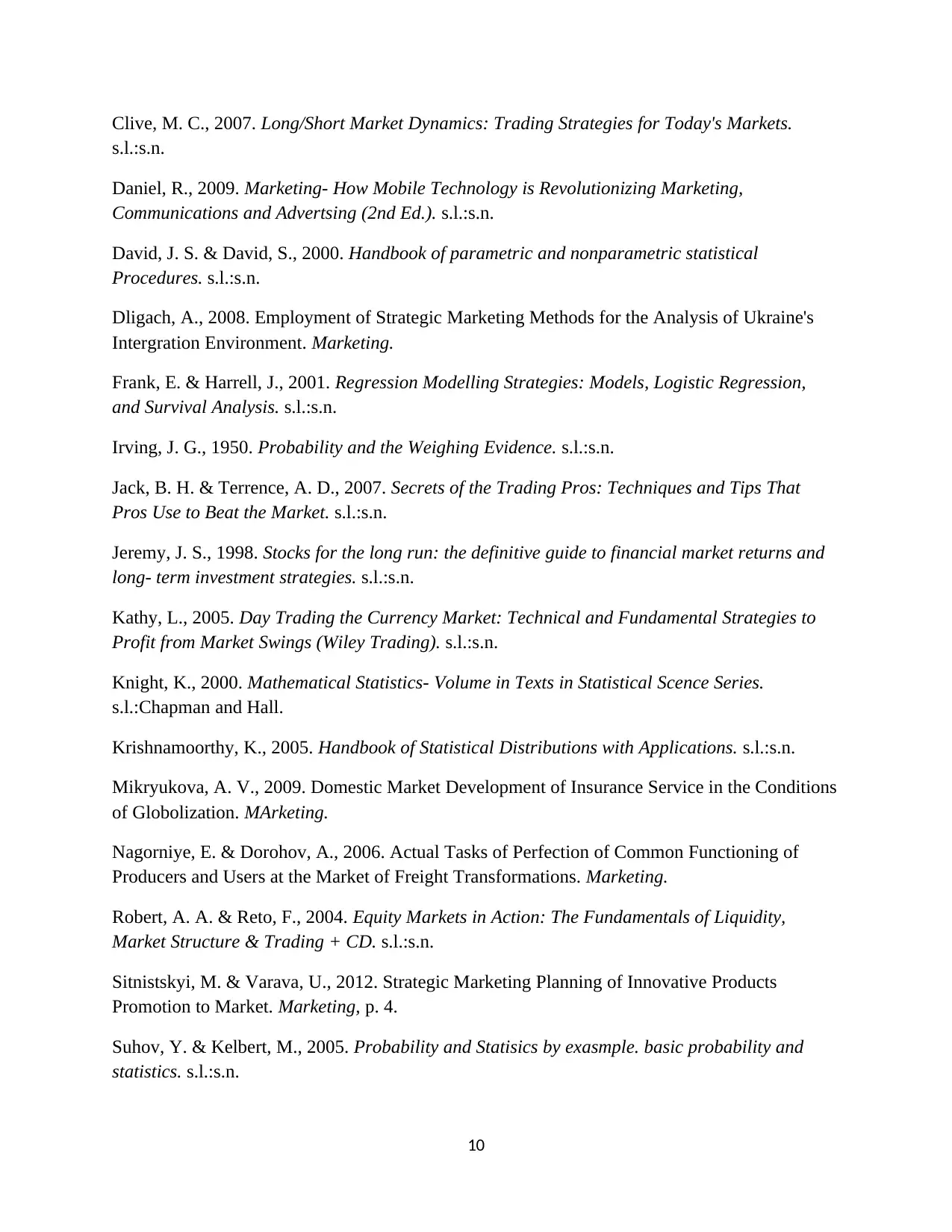
Clive, M. C., 2007. Long/Short Market Dynamics: Trading Strategies for Today's Markets.
s.l.:s.n.
Daniel, R., 2009. Marketing- How Mobile Technology is Revolutionizing Marketing,
Communications and Advertsing (2nd Ed.). s.l.:s.n.
David, J. S. & David, S., 2000. Handbook of parametric and nonparametric statistical
Procedures. s.l.:s.n.
Dligach, A., 2008. Employment of Strategic Marketing Methods for the Analysis of Ukraine's
Intergration Environment. Marketing.
Frank, E. & Harrell, J., 2001. Regression Modelling Strategies: Models, Logistic Regression,
and Survival Analysis. s.l.:s.n.
Irving, J. G., 1950. Probability and the Weighing Evidence. s.l.:s.n.
Jack, B. H. & Terrence, A. D., 2007. Secrets of the Trading Pros: Techniques and Tips That
Pros Use to Beat the Market. s.l.:s.n.
Jeremy, J. S., 1998. Stocks for the long run: the definitive guide to financial market returns and
long- term investment strategies. s.l.:s.n.
Kathy, L., 2005. Day Trading the Currency Market: Technical and Fundamental Strategies to
Profit from Market Swings (Wiley Trading). s.l.:s.n.
Knight, K., 2000. Mathematical Statistics- Volume in Texts in Statistical Scence Series.
s.l.:Chapman and Hall.
Krishnamoorthy, K., 2005. Handbook of Statistical Distributions with Applications. s.l.:s.n.
Mikryukova, A. V., 2009. Domestic Market Development of Insurance Service in the Conditions
of Globolization. MArketing.
Nagorniye, E. & Dorohov, A., 2006. Actual Tasks of Perfection of Common Functioning of
Producers and Users at the Market of Freight Transformations. Marketing.
Robert, A. A. & Reto, F., 2004. Equity Markets in Action: The Fundamentals of Liquidity,
Market Structure & Trading + CD. s.l.:s.n.
Sitnistskyi, M. & Varava, U., 2012. Strategic Marketing Planning of Innovative Products
Promotion to Market. Marketing, p. 4.
Suhov, Y. & Kelbert, M., 2005. Probability and Statisics by exasmple. basic probability and
statistics. s.l.:s.n.
10
s.l.:s.n.
Daniel, R., 2009. Marketing- How Mobile Technology is Revolutionizing Marketing,
Communications and Advertsing (2nd Ed.). s.l.:s.n.
David, J. S. & David, S., 2000. Handbook of parametric and nonparametric statistical
Procedures. s.l.:s.n.
Dligach, A., 2008. Employment of Strategic Marketing Methods for the Analysis of Ukraine's
Intergration Environment. Marketing.
Frank, E. & Harrell, J., 2001. Regression Modelling Strategies: Models, Logistic Regression,
and Survival Analysis. s.l.:s.n.
Irving, J. G., 1950. Probability and the Weighing Evidence. s.l.:s.n.
Jack, B. H. & Terrence, A. D., 2007. Secrets of the Trading Pros: Techniques and Tips That
Pros Use to Beat the Market. s.l.:s.n.
Jeremy, J. S., 1998. Stocks for the long run: the definitive guide to financial market returns and
long- term investment strategies. s.l.:s.n.
Kathy, L., 2005. Day Trading the Currency Market: Technical and Fundamental Strategies to
Profit from Market Swings (Wiley Trading). s.l.:s.n.
Knight, K., 2000. Mathematical Statistics- Volume in Texts in Statistical Scence Series.
s.l.:Chapman and Hall.
Krishnamoorthy, K., 2005. Handbook of Statistical Distributions with Applications. s.l.:s.n.
Mikryukova, A. V., 2009. Domestic Market Development of Insurance Service in the Conditions
of Globolization. MArketing.
Nagorniye, E. & Dorohov, A., 2006. Actual Tasks of Perfection of Common Functioning of
Producers and Users at the Market of Freight Transformations. Marketing.
Robert, A. A. & Reto, F., 2004. Equity Markets in Action: The Fundamentals of Liquidity,
Market Structure & Trading + CD. s.l.:s.n.
Sitnistskyi, M. & Varava, U., 2012. Strategic Marketing Planning of Innovative Products
Promotion to Market. Marketing, p. 4.
Suhov, Y. & Kelbert, M., 2005. Probability and Statisics by exasmple. basic probability and
statistics. s.l.:s.n.
10
Paraphrase This Document
Need a fresh take? Get an instant paraphrase of this document with our AI Paraphraser
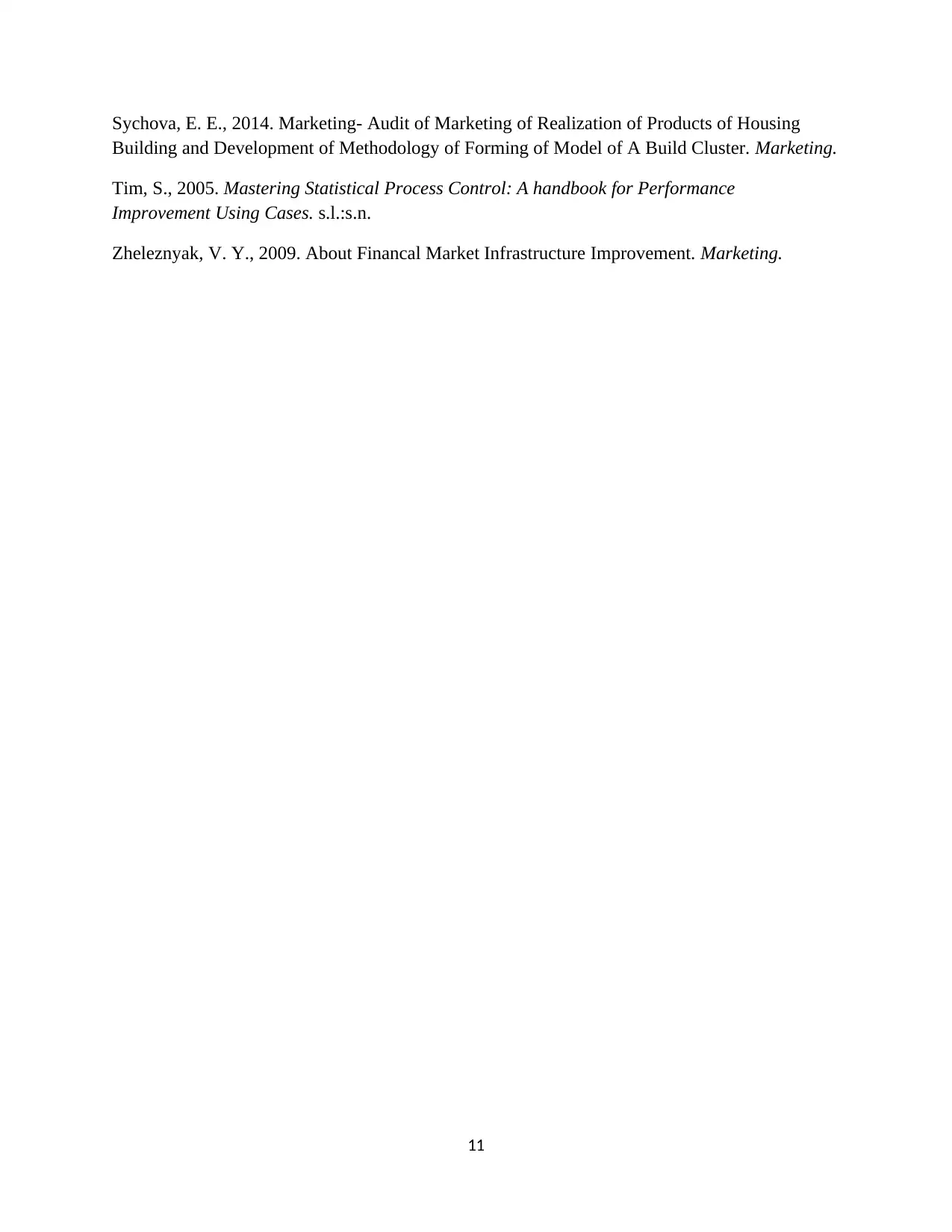
Sychova, E. E., 2014. Marketing- Audit of Marketing of Realization of Products of Housing
Building and Development of Methodology of Forming of Model of A Build Cluster. Marketing.
Tim, S., 2005. Mastering Statistical Process Control: A handbook for Performance
Improvement Using Cases. s.l.:s.n.
Zheleznyak, V. Y., 2009. About Financal Market Infrastructure Improvement. Marketing.
11
Building and Development of Methodology of Forming of Model of A Build Cluster. Marketing.
Tim, S., 2005. Mastering Statistical Process Control: A handbook for Performance
Improvement Using Cases. s.l.:s.n.
Zheleznyak, V. Y., 2009. About Financal Market Infrastructure Improvement. Marketing.
11
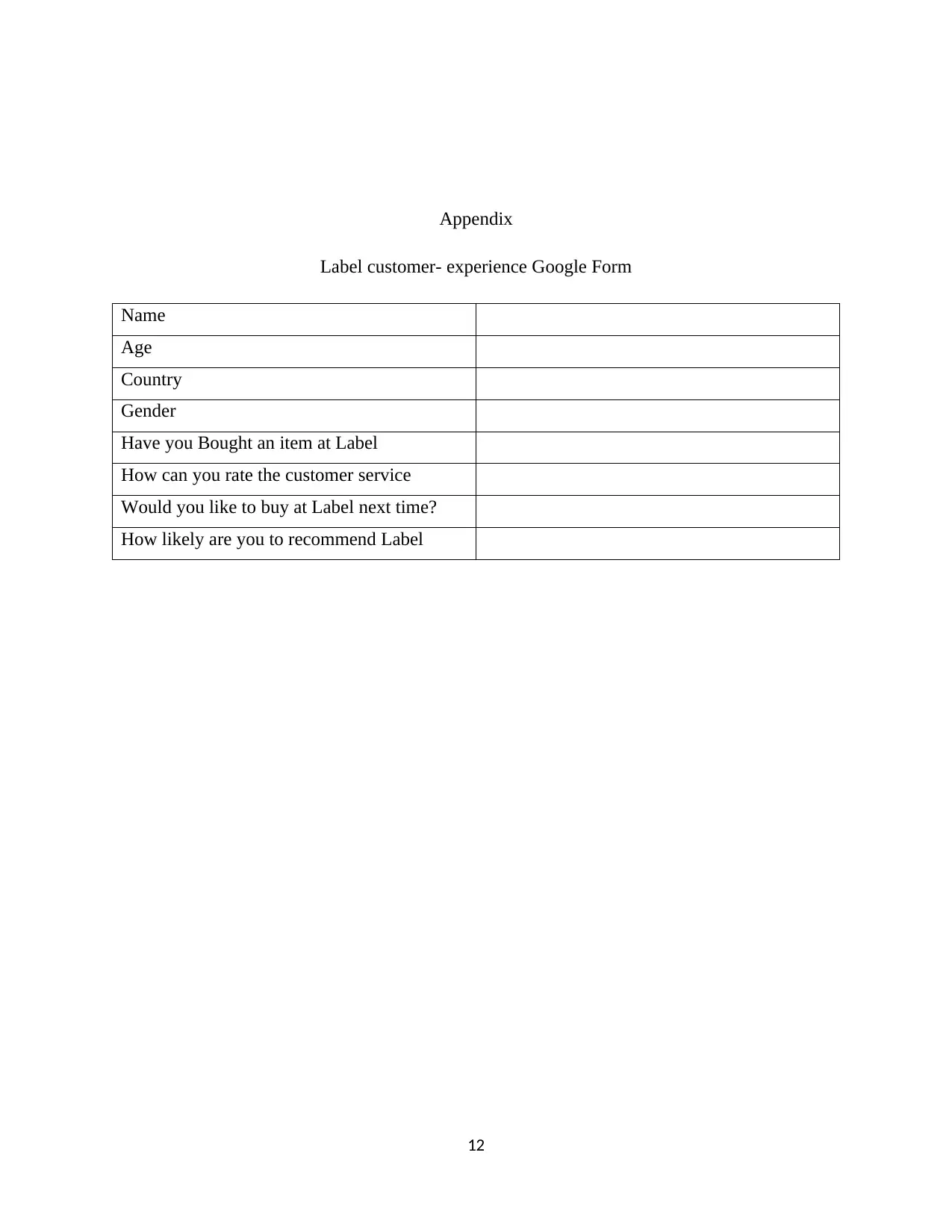
Appendix
Label customer- experience Google Form
Name
Age
Country
Gender
Have you Bought an item at Label
How can you rate the customer service
Would you like to buy at Label next time?
How likely are you to recommend Label
12
Label customer- experience Google Form
Name
Age
Country
Gender
Have you Bought an item at Label
How can you rate the customer service
Would you like to buy at Label next time?
How likely are you to recommend Label
12
⊘ This is a preview!⊘
Do you want full access?
Subscribe today to unlock all pages.

Trusted by 1+ million students worldwide
1 out of 12
Related Documents
Your All-in-One AI-Powered Toolkit for Academic Success.
+13062052269
info@desklib.com
Available 24*7 on WhatsApp / Email
![[object Object]](/_next/static/media/star-bottom.7253800d.svg)
Unlock your academic potential
Copyright © 2020–2025 A2Z Services. All Rights Reserved. Developed and managed by ZUCOL.





